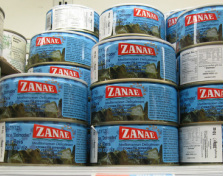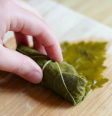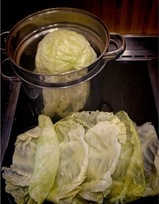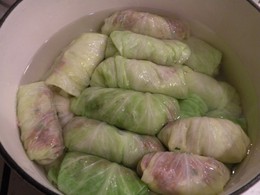Dolma 101: Grape Leaves Versus Cabbage
Dolmadakia/dolmathakia (ντολμαδάκια), pronounced dohl-mah-THAH-kyah, are small dolmades made with grape leaves (klimatofila) and filled with a ground lamb or beef (or a combination of both)-and-rice stuffing. Dolmadakia made with rice alone are called dolmadakia/dolmathakia gialantzi (ντολμαδάκια γιαλαντζί), pronounced yah-lahnd-ZEE, and, because they’re meatless, can be eaten during Lent or fasting periods (for more on Lenten meals see our blogs on the Greek foods of Lent). Both dolmadakia versions are traditionally served as mezedakia (appetizers) with lemon wedges.

Lahanodolmades are hearty, delicious, and in many Greek homes are served on Sunday afternoon following church services. This is the Greek version of comfort food at its very best!
It’s a Wrap & Roll!
Off the Grape Vine

Following is the essential preparation that will make your mezedes to die for!
1. Remove the leaves from the jar and carefully unroll them but do not separate. Rinse the leaves under cool water (to remove the brine). Fill a large pot halfway up the sides with water and bring to a boil over medium-high heat. Carefully add the leaves to the boiling water, return it to a boil, and blanch them until they are bright green—this will only take a couple of minutes, so don’t go anywhere! Drain immediately and rinse under cool water. Drain well and transfer to a large plate. Handle the leaves gently to avoid tearing. Do not throw away any damaged leaves—you’ll need them later.
2. When the leaves are cool enough to handle, line the bottom of a large saucepot with a layer of the reserved damaged leaves. This will keep the dolmadakia from touching the bottom of the pot and burning.
3. Working with one leaf at a time, snip off and discard the tough stem extending from the leaf.
Stuff it!
Cook it right!
|
As you fill the pot, make sure the dolmadakia are placed neatly and snuggly against each other in each layer so they don’t move when cooking. When the pot is full, follow your recipe for the amount of broth and any flavorings to add.
Cover the top of the dolmadakia in the pot with an inverted heatproof shallow bowl. The bowl should be small enough to not touch the sides of the pot but large enough that it covers the dolmadakia. The bowl will keep the dolmadakia from rising to the top of the pot and unraveling while cooking, and will ensure that they cook properly. Follow your recipe for the remaining cooking directions. |
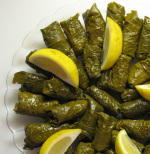
Dolmadakia are typically served with feta, kalamata olives, and assorted dips. For a meze party, pair with ouzo, Ageri (Αγέρι) semi-dry white wine or Rosé Nico Lazaridi.
Cabbage-Patch
TIP: This would be a good time to make your filling.
Stuff it!
Cook it right!
|
As you fill the pot, make sure the dolmades are placed neatly and snuggly against each other in each layer so they don’t move while cooking.
When the pot is full, follow your recipe for the amount of broth and any flavorings to add. Cover the top of the dolmades with an inverted heatproof shallow bowl. The bowl should be small enough to not touch the sides of the pot but large enough that it covers the dolmades. The bowl will keep the dolmades in place while cooking, and will ensure that they cook properly. Follow your recipe for the remaining cooking directions. |

For the perfect presentation, it's best to arrange the rolls on individual serving plates and then top them with the sauce (don't drown them!). Feel free to garnish with lemon slices, dill, chives, or parsley to add color to your creation. Add a Greek salad and a glass of red Erythros (Ερυθρός) wine to complete the meal!

Two kinds of dolmadakia recipes (with meat and without) are in our Meze cookbook, available on Amazon! Stay tuned for more upcoming how-to Greek foodie blogs.
Thanks for following us and we’ll see you next Monday!
Until then~
Kali orexi! Good appetite!
Kelly







